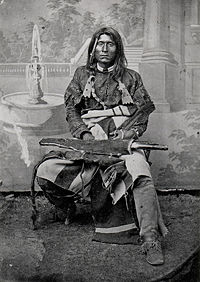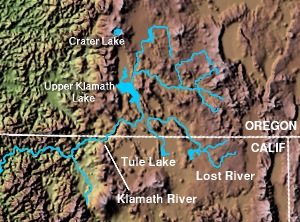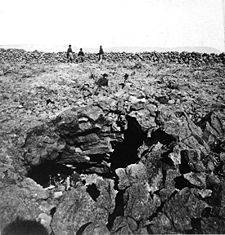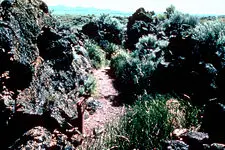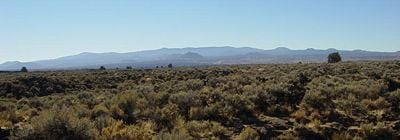Kintpuash
| Kintpuash | |
|---|---|
| Captain Jack in 1864
| |
| Born | c. 1837 Tule Lake area |
| Died | October 3, 1873 (age 35-37) Fort Klamath |
| Alias(s) | Captain Jack |
| Conviction(s) | Murder |
| Penalty | Death by hanging |
| Status | Deceased |
Kintpuash, also known as Captain Jack (circa 1837 - October 3, 1873), was a chief of the Native American Modoc tribe of California and Oregon, and was their leader during the Modoc War of 1872–1873.
Early years
The Modoc and Klamath were neighboring tribes in the Cascade Range of what is now southern Oregon and northern California. Plateau tribes, they shared a common Penutian language.
Though related, they were individual tribes who lived separately within their own villages and had their own customs. Neighbors and sometimes rivals, they would ally for war. There was some intermarriage between members of these two groups.
Kintpuash was born around 1837 in the Lost River village of Wa’Chamshwash. In 1852 he witnessed the death of his father when a Modoc village was slaughtered by a volunteer regiment seeking retaliation for a Pitt River tribe's attack on an emigrant party.[1] He responded by developing a hostility towards white people which he carried throughout his life.
Reservation life
As the United States expanded westward, the government pressured the Modoc to give up their traditional territory and move with the Klamath to a reservation near Upper Klamath Lake. This land had traditionally been Klamath land, and when the Modoc joined them in 1864 they were viewed as intruders. The tract of land set aside for them did not provide enough food for the combined tribes, and poverty and sickness increased inter-tribal tensions.
Kintpuash's band was forced to move to another part of the reservation to avoid hostilities. Several attempts were made to find a suitable location. The Klamaths harassed the band until Kintpuash and his followers finally left the reservation.
Acknowledging the bad feeling between Kintpuash's band and the Klamaths, Alfred B. Meacham recommended to the Commissioner of Indian Affairs in Washington, D.C. that Kintpuash's Modocs be given a separate reservation. Pending action on the recommendation, Meacham instructed Kintpuash (now known as Captain Jack) to remain at Clear Lake.
He and his band chose instead to leave the reservation and return to their original homelands in the Lost River region. By this time a number of settlers had taken up land there. In 1869, the Modoc were rounded up by the United States Army and returned to the Klamath Reservation, but conditions had not improved, and Captain Jack led a band of about 180 Modoc to the Tule Lake area in April, 1870.
Battle of Lost River
In 1872 the Army was sent to capture Captain Jack's band and return them to the reservation. On November 28 Captain James Jackson, commanding 40 troops, left Fort Klamath for Captain Jack's camp on Lost River. The troops, reinforced by a group of citizens and a band of volunteer militia, arrived in Captain Jack's camp on November 29. Wishing to avoid conflict, Captain Jack agreed to go to the reservation, but the situation became tense when it was demanded that they disarm. Captain Jack had never fought the Army, and was alarmed at this command, but finally agreed to put down his weapons.
As the rest of the Modoc were following his lead, it is believed that a Modoc warrior and a Lieutenant got into a verbal argument, pulled their revolvers and shot at each other, both missing their target. The Modoc scrambled to regain their recently cast aside weapons, and fought a short battle before fleeing towards the border of California. After driving the Modoc from camp, Captain Jackson ordered the troops to retreat to await reinforcements. However the militia pursued them and a short battle followed.
Lava Beds Stronghold
The brief battle, known as the Battle of Lost River, prompted Jack to lead his band into the naturally fortified area in the Lava Beds east of Mount Shasta, now known as Lava Beds National Monument. The band settled in a natural fortress, now known as Captain Jack's Stronghold, consisting of many caves and trenches in the lava beds. When they were finally located, the Army quickly launched an attack on January 17, 1873; the Army was left with 35 dead and many wounded, while the Modoc suffered no casualties.
Captain Jack's advisers, not understanding the differences between Modoc and European-American culture, suggested that the Army would leave in response to killing their leader, General Edward Canby. Jack hoped, to the contrary, for a peaceful solution to the conflict, and entered into negotiations with a Federal peace commission. During the months-long negotiations, the Modoc hawks gained in influence. Jack was shamed, his opponents even dressing him in the clothing of a Modoc woman to symbolically strip him of his manhood. To bolster his influence, Jack agreed to their plan: he called for a meeting with the commission (of which Canby was by then the chair) with the intention of killing them all.
During a conference on April 11, Captain Jack and several other Modocs drew pistols upon a pre-arranged signal, and killed two leading members of commission; Captain Jack fatally shot Canby and Boston Charley dispatched Californian clergyman Reverend Eleazar Thomas.[2] Canby was the only general killed during the Indian Wars (Custer's permanent rank was lieutenant colonel). The murder had far from the desired effect, and Canby's successor, General Jefferson C. Davis, brought in over 1000 soldiers as reinforcements. On April 14, the Army again attacked the stronghold, this time forcing the Modoc to flee.
Surrender and death
After six months in the Lava Beds, the Modoc were badly outnumbered, short of water and supplies, and lacking horses. Some continued to fight the army, while others began to surrender. A number of Jack's followers began to desert him. He successfully avoided the Army until a number of Modoc agreed to hunt him down and turn him in; these men included Hooker Jim, Bogus Charley, Shacknasty Jim and Steamboat Frank.
At Big Sand Butte Captain Jack led his band - by then only 33 - out of an army trap involving more than three hundred soldiers. But one by one the Modocs surrendered, with the guarantee they would be treated as prisoners of war.
On June 1, Captain Jack himself surrendered, ceremonially laying down his rifle. He was taken to Fort Klamath where a military tribunal found him and several other Modocs guilty of war crimes and sentenced them to death. On October 3, 1873 he was hanged for the murder of General Canby and Reverend Thomas. Black Jim, John Schonchin and Boston Charley were hung with him. Most of his people, including his widow and his sister, were forced to relocate to Indian territory in Oklahoma, where many of their descendants remain.
After the execution, Captain Jack's body was transported by freight train to Yreka, with reports that the body was embalmed to be used as a carnival attraction in the Eastern states.[2] While it is not clear what happened to the body of Kintpuash after his death, it is known that his head was severed and sent to Washington, DC. On October 25th, Colonel Wheaton wrote the Surgeon General notifying him of the shipment of the four heads of the executed for the Army Medical Museum.[3][4]
In 1898, the skulls were transferred to the Smithsonian Institution. In the 1970s, descendants of Captain Jack learned that the skull was at the Smithsonian and requested its return. In 1984, the Smithsonian returned the remains to Kintpuash's relatives, along with the skulls of Boston Charley, Black Jim, John Schonchin and an unnamed woman whose remains were collected from the Lava Bed Battlefields.[5][6]
Notes
- ↑ Rebecca Bales. 2005. Winema and the Modoc War: One Woman's Struggle for Peace. Prologue Magazine. Retrieved February 19, 2009.
- ↑ 2.0 2.1 Dee Brown. 1975. Bury My Heart At Wounded Knee: an Indian History of the American West. New York: Holt, Rinehart and Winston. (ISBN 9780030853227)
- ↑ National Park Service. Lava Beds NM: Modoc War Retrieved February 19, 2009.
- ↑ Army and Navy Journal October 25, 1873, p. 16.
- ↑ Smithsonian Institution National Museum of Natural History, Repatriation Office. Repatriation of Modoc Remains Retrieved February 19, 2009.
- ↑ Robert Lynn Montgomery. 1994. Register to the Papers of John Lawrence Angel National Anthropolical Archives Smithsonian Institution. Retrieved February 19, 2009.
ReferencesISBN links support NWE through referral fees
- Beck, Warren A. and Ynez D. Hasse. The Modoc War, 1872-1873 California State Military Department. Retrieved February 19, 2009.
- Foster, Doug. “Imperfect Justice: The Modoc War Crimes Trial of 1873.” Oregon Historical Quarterly 100, 1999: 246-287.
- Gooch, Sara. 1990. Native American issue: the Northern Paiutes, the Achumawi, the Modocs. Alturas, Calif. : Modoc County Historical Society. OCLC 55013449
- Murray, Keith A. 1959. The Modocs and Their War. Norman, OK.
- Oregon Historical Society. 2002. Kintpuash (Captain Jack) Retrieved February 19, 2009.
- Quinn, Arthur. 1998. Hell With the Fire Out: A History of the Modoc War. Faber & Faber. ISBN 9780571199372
Credits
New World Encyclopedia writers and editors rewrote and completed the Wikipedia article in accordance with New World Encyclopedia standards. This article abides by terms of the Creative Commons CC-by-sa 3.0 License (CC-by-sa), which may be used and disseminated with proper attribution. Credit is due under the terms of this license that can reference both the New World Encyclopedia contributors and the selfless volunteer contributors of the Wikimedia Foundation. To cite this article click here for a list of acceptable citing formats.The history of earlier contributions by wikipedians is accessible to researchers here:
The history of this article since it was imported to New World Encyclopedia:
Note: Some restrictions may apply to use of individual images which are separately licensed.
